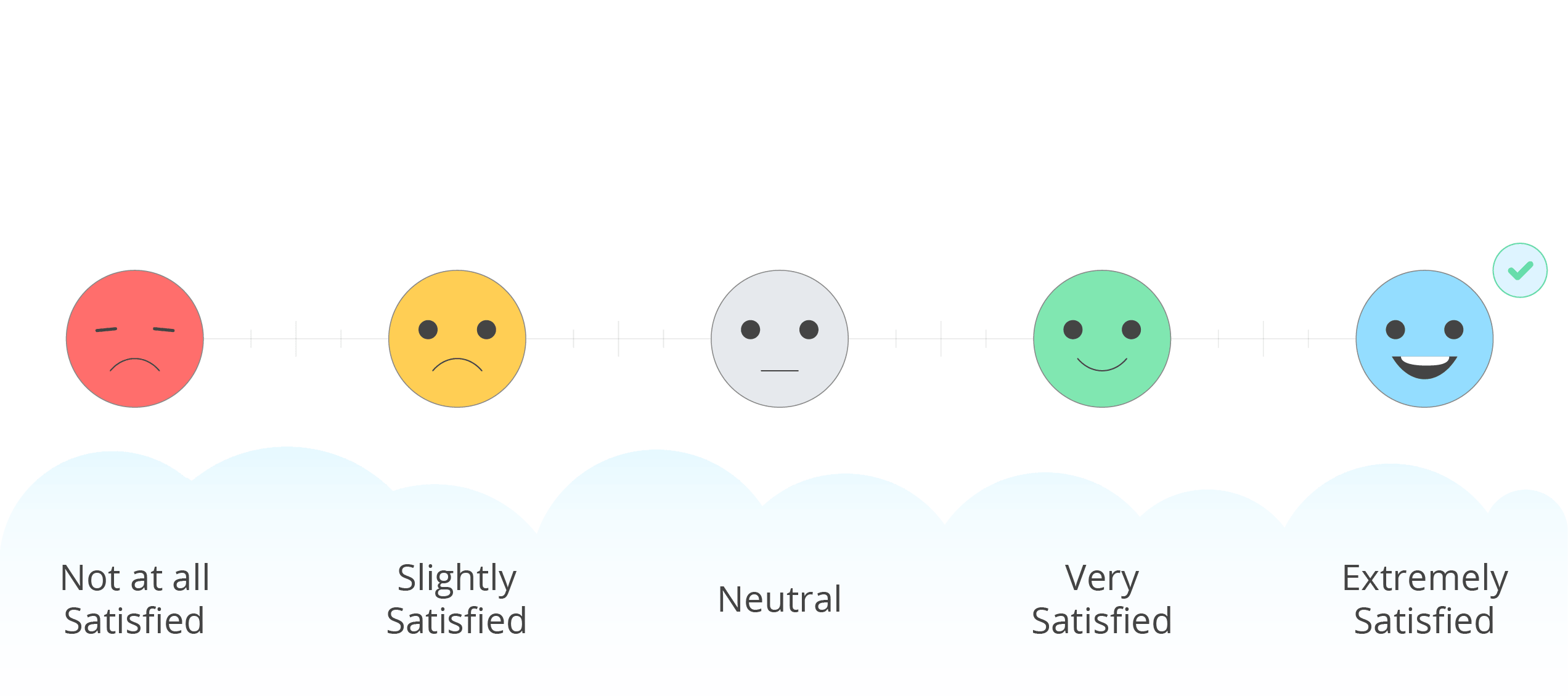Two thumbs up! Five stars! There are many types of scales designed to let the public know the quality of something. But what about when you want to get the public’s opinion on something? Whether you’re a business surveying customers or a market researcher, a popular way to survey people is using a Likert scale.
Create your Likert-based survey, form, or poll now!
Likert Scale Definition: History and Usage
What is a Likert scale and how do you use one? Firstly, the Likert scale is named after American social scientist Rensis Likert. Likert devised the psychometric approach in 1932 for conducting social and educational research. Today, Likert-type scales are considered some of the best survey tools for researching popular opinions. As a result, they’re often used for customer satisfaction surveys or marketing research surveys.
On a Likert scale, a person selects one option among several that reflects how much they agree with a statement. In other words, the scale generally consists of five or seven balanced responses that people can choose from, with a neutral midpoint. However, there can be as few as two responses (with no neutral response) or as many as ten. Now, it’s very common for companies to use these scales when they want to evaluate a customer’s level of satisfaction during a recent experience.
Later on, you’ll see many examples of Likert survey scales. However, to be sure we’re on the same page here’s a typical question using 5 points:
SurveyLegend provides quality support to its customers:
- Strongly Disagree
- Somewhat Disagree
- Neither Agree Nor Disagree
- Somewhat Agree
- Strongly Agree
Hint: The correct answer is 5…at least that’s what our customers are saying!
Are Likert Scales Ordinal or Interval?
Almost everyone agrees that the Likert rating scale provides ordinal data (data which is measured along a scale, but the distances between each point are unknown). However, many believe this scale also provides interval data (data that is measured along a scale, with each point placed at equal distances from one another).
Here’s what we think: Likert survey scales provide ordinal data, as the results naturally represent someone’s preferences. For example, we know that a 4 is better than a 3. However, it’s not interval data because we don’t know exactly what constitutes a 4 versus a 3 in someone’s mind.
That said, when a survey has enough questions, many researchers use the data to come up with reliable averages. This means Likert scales “approach” the definition of interval data. We think Dr. David L. Morgan from the Portland State University’s Sociology Department summed up the interval nature of the scale well. He says, “The key point here is to use multiple items, where any one of them may be too weak to provide an adequate measure, but the combination of them is much stronger.”
Are Likert Scales Quantitative or Qualitative?
Likert scales give quantitative value to qualitative data. For example, it may be designed to measure how much a person agrees with a statement regarding a product’s value and assigns a data point to it. This is one reason why the scale is almost universally loved. Researchers appreciate that Likert rating scale questions use a universal method of collecting data, so the results can be easily understood. Additionally, CEOs and marketers like that they can say someone thinks their product is “excellent” because they assigned a “10” to it.
Why Use a Likert Scale? Advantages and Disadvantages
There are Likert scale advantages and disadvantages. However, there are many more pros than cons!
Likert scales are easy for people to understand and complete. Because questions using the Likert method follow a scale, respondents don’t have to answer yes or no, or either-or. Instead, they can choose to be neutral. All of this means that they wind up delivering better response rates! In addition, questions are easier to analyze and report on than open-ended or fill-in-the-blank questions, which are more difficult to analyze because the answers haven’t been configured in advance.
The one drawback is that you don’t always get in-depth feedback. Consider a restaurant. Sure, you may know someone is dissatisfied with your restaurant because they only gave you one star. But, you won’t know why they were dissatisfied (Was it the food quality? The service? Cleanliness?). To solve this, it’s important to ask multiple questions about different aspects of the customer’s visit. After that, ask for their overall satisfaction level.
Difference Between 5 Point Likert Scale and a 7 Point Scale
Most researchers agree that the best Likert scales are the 5-point and 7-point varieties. This simply refers to how many responses the person has to choose from. Most Likert scales you see are going to be odd-numbered. They will have an equal number of positive and negative responses on either side of a neutral response. Poor to excellent Likert scales are popular as you’ll see in one of our 5 point Likert scale templates below.
So why are 5 point and 7 point considered ideal? Because if you offer less than five options, online survey takers may be limited in their responses; they may resort to picking the “most” applicable answer. As a result, you’re deprived of their true opinion. On the other hand, if you go above seven, respondents may feel overwhelmed or annoyed; they may just pick a random answer to move along quickly.

Other Point Variations in Likert Scales
While the 5 point and 7 point Likert scale are the most popular, there are other variations.
2-Point Likert Scale
The simplest form of this scale provides no neutral option (yes/no).
3-Point Likert Scale
The 3 point scale is used similarly to the 2 point version, but introduces a neutral option (yes/unsure/no).
4-Point Likert Scale
This version forces respondents to make a choice. Consider this 4 point smiley face Likert scale, where the faces represent: Extremely Dissatisfied, Somewhat Dissatisfied, Satisfied, and Extremely Satisfied:

There is no neutral choice. However, if a researcher wants to find a neutral point, they can average together Somewhat Dissatisfied and Satisfied.
6-Point Likert Scale
The 6 point scale is meant to provide more options for respondents. Because it is an even point scale, there is no neutral option.
9-Point Likert Scale
This Likert scale is used to offer respondents a wider variety of choices. Additionally, it provides a higher degree of measurement precision, with a neutral option. However, it’s not commonly used as it can take respondents longer to make their selections which can result in less accurate responses as participants speed through the survey.
10-Point Likert Scale
This provides a greater Likert scale level of measurement precision, like the 9 point Likert scale. However, it does not include a neutral option.
5 Tips for Creating a Likert Scale
1. Ask multiple questions
It’s often not enough to ask one general question about a particular topic, opinion, or experience. If you do, you won’t see the full picture. Asking multiple questions remedies this, taking into consideration all of the factors that could have contributed to this response.
2. Avoid using different scales
Mixing different scales within your surveys can cause respondent confusion. Bonus: Using only one scale will also make your final analysis that much easier.
3. Label the numeric responses
Do not simply attach a number to possible responses. Always include wording on your scale question, otherwise online survey takers may confuse which numbers are positive and which are negative.
4. Create unbiased responses
To improve Likert scale validity and reliability, stay away from survey questions that may lead people to answer a certain way. For example, you don’t want to force them to choose between extremes as it can skew your results.
5. Keep it simple
Creating a Likert scale survey doesn’t need to be complicated. In fact, the best survey questions are concise and to the point. For example, long, complex questions tend to lose readers or test their patience. Additionally, inadvertently asking two questions in one can leave respondents unsure of how to answer.
Likert Scale Examples and Questions
Below are a number of examples of Likert scales using different numbers of points that may provide inspiration when developing your survey. However, please note that the numbers in the answers indicate the relative position of items, but not the magnitude of difference. Additionally, you do not have to include numbers in your survey questions if you prefer not to.
 Comparing 2 Products
Comparing 2 Products
 Quality
Quality
 Support / Opposition
Support / Opposition
 Barriers
Barriers
 Likelihood
Likelihood
 Good / Bad
Good / Bad
 Reflect Me
Reflect Me
 My Beliefs
My Beliefs
 Familiarity Level
Familiarity Level
 Awareness Level
Awareness Level
 Knowledge of Action
Knowledge of Action
 Affect on …
Affect on …
 Acceptability Level
Acceptability Level
 Appropriateness Level
Appropriateness Level
 Importance Level
Importance Level
 Concern Level
Concern Level
 Difficulty Level
Difficulty Level
 Influence Level
Influence Level
 Probability Level
Probability Level
 Overall Impression
Overall Impression
 Agreement Level
Agreement Level
 Level of Agreement
Level of Agreement
 Satisfaction Level
Satisfaction Level
 Level of Satisfaction
Level of Satisfaction
 Frequency
Frequency
 How Often?
How Often?
How to Analyze Likert Scale Data
You will find many ideas out there about how to analyze Likert scale data. For example, many people want to know how to calculate mean score for Likert scale data, which would simply be the sum of all numbers divided by the count. However, as mentioned earlier, these scales provide ordinal data, and the values between points cannot be considered equal. Therefore, using a mean (the average of all the numbers) is not appropriate for analysis.
Instead, it is recommended that you use a mode score for easy inappropriate for ordinal data. First, to calculate the mode score for Likert scale data, simply determine the number that appears the most. So, let’s say you surveyed ten people on the quality of a product on a 5 point scale and the results were as follows:
5, 5, 4, 1, 4, 4, 4, 4, 4, 3
In this example, the mode would be 4, as it appears the most. You’ll note that in this example, the mean would also have been 4. However, in highly skewed distributions, these numbers would be different as you’ll see below:
1, 1, 1, 1, 5, 5, 5, 1, 1, 1
Here, the mode would be 1. Most people clearly don’t like the product. However, the mean would have been 3, but concluding that most people think the product is average is clearly not the case, which is why a mode score is most appropriate when analyzing Likert scale data.
Live Likert Scale Example
Want to see a Likert scale in action? Below is a Likert scale example created using SurveyLegend’s opinion scale option. Go ahead and try it for yourself, it’s live!
Conclusion
A Likert scale is a great option for businesses and researchers wanting an easy way to survey customers or the general public. When it’s time to create your survey, choose SurveyLegend for easy design and analysis. SurveyLegend offers the best online survey software, with countless survey samples and templates. So, do you want to switch languages to have your Likert scale in Spanish or another language? We let you easily create Likert scale questions that are responsive, beautifully adjusting even to the small mobile phone screens.
Have you used a Likert scale in your research? Did you find it easy to use and analyze? Let us know in the comments!
Create your Likert-based survey, form, or poll now!
Frequently Asked Questions (FAQs)
Yes. It’s named after American social scientist Rensis Likert, who created the scale.
A Likert scales measure how much a person agrees with a statement, providing five or seven balanced responses that people can choose from with a neutral midpoint.
A Likert scale provides ordinal data (data that is measured along a scale, but the distances between each point are unknown).
Likert scales give quantitative value to qualitative data, assigning a data point to a statement.
A mode score should be used, to determine which number appears the most.





